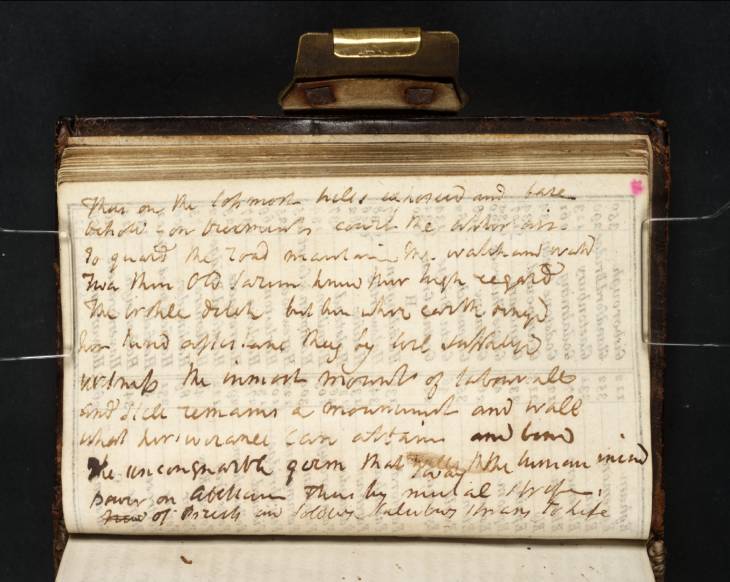Joseph Mallord William Turner Inscription by Turner: Draft of Poetry 1811
Joseph Mallord William Turner,
Inscription by Turner: Draft of Poetry
1811
Joseph Mallord William Turner 1775–1851
Folio 33 Verso:
Inscription by Turner: Draft of Poetry 1811
D08424
Turner Bequest CXXIII 33a
Turner Bequest CXXIII 33a
Inscribed by Turner in ink (see main catalogue entry) on white wove printing paper, 75 x 117 mm
Accepted by the nation as part of the Turner Bequest 1856
References
1862
Walter Thornbury, The Life of J.M.W. Turner, R.A. Founded on Letters and Papers Furnished by his Friends and Fellow-Academicians, London 1862, vol.II, p.19.
1897
Walter Thornbury, The Life of J.M.W. Turner, R.A. Founded on Letters and Papers Furnished by his Friends and Fellow-Academicians: A New Edition, Revised with 8 Coloured Illustrations after Turner’s Originals and 2 Woodcuts, London 1897, p.207.
1909
A.J. Finberg, A Complete Inventory of the Drawings of the Turner Bequest, London 1909, vol.I, p.346, CXXIII 33a, as ‘Verses’.
1966
Jack Lindsay, The Sunset Ship: The Poems of J.M.W. Turner, Lowestoft 1966, p.110.
1987
Andrew Wilton, Turner in his Time, London 1987, p.103.
1990
Andrew Wilton and Rosalind Mallord Turner, Painting and Poetry: Turner’s ‘Verse Book’ and his Work of 1804–1812, exhibition catalogue, Tate Gallery, London 1990, p.170.
2001
Andrew Kennedy, ‘Salisbury’ in Evelyn Joll, Martin Butlin and Luke Herrmann (eds.), The Oxford Companion to J.M.W. Turner, Oxford 2001, p.[278].
2006
Andrew Wilton, Turner in his Time, revised ed., London 2006, p.90, as ‘CXXII’.
The whole page is taken up with the following lines of verse:
There on the topmost hills exposed and bare
Behold yon [...] court the upper air
To guard the road maintain the watch and ward
Twas then old Sarum knew their high regard
The triple ditch but [?here] where earth denyd
Her kind assistance they by toil supplyd
Witness the inmost mount of labour all
And still remains a monument and wall
What perseverance can attain and bind
The unconquerable germ that <wills> [‘sway’ inserted below] the human mind
Power on Abettance thus by mutual strife
<Now> of Priests and Soldiers Salisbury sprang to life1
Behold yon [...] court the upper air
To guard the road maintain the watch and ward
Twas then old Sarum knew their high regard
The triple ditch but [?here] where earth denyd
Her kind assistance they by toil supplyd
Witness the inmost mount of labour all
And still remains a monument and wall
What perseverance can attain and bind
The unconquerable germ that <wills> [‘sway’ inserted below] the human mind
Power on Abettance thus by mutual strife
<Now> of Priests and Soldiers Salisbury sprang to life1
Interspersed with drawings and the printed pages of Coltman’s British Itinerary, sixty-nine pages of this sketchbook are given over wholly or partly to these verses which Turner intended as a commentary for publication with the Picturesque Views on the Southern Coast of England which he sketched on the 1811 West Country tour (see the introduction to the sketchbook). The first lines are on folio 18 verso (D08396), and the last on folio 207 verso (D08736; CXXIII 204a).
‘Sarum’, as a generic term for the Salisbury area, first appears on folio 29 recto (D08415). The medieval settlement of Old Sarum, mentioned here, lay on an important Iron Age hill-fort site, occupied in turn by the Romans, Saxons and Normans but later abandoned in favour of modern Salisbury, founded just to the south in 1226.2 What may be a small sketch of the site is on folio 210 recto (D08740; CXXIII 207). The passage on folio 30 verso (D08418), briefly continued on folio 31 recto (D08419), considers the ancient, nearby Icknield Way.
Salisbury was a major staging post for the West Country – see the introduction to the 1811 tour, and the list of banknotes inside the back cover of the present book (D40906). Turner first sketched there in the 1795 Isle of Wight sketchbook (Tate; Turner Bequest XXIV) and subsequently made numerous important watercolours3 including Salisbury, Wiltshire of about 1828 (Salisbury and South Wiltshire Museum),4 showing Salisbury Cathedral from Old Sarum, itself based on a 1795 drawing (Tate D00421; Turner Bequest XXIV 14b). As Andrew Kennedy has noted, the next passage, on folio 35 verso (D08428), goes on to consider the modern freedom of the locals from the feudal obligations formerly owed to ‘Priests and Soldiers’, although Old Sarum itself remained an electoral ‘rotten borough’.5
Matthew Imms
June 2011
See transcriptions (followed here with slight variations) in Lindsay 1966, p.110, part of line five and lines six to ten as ‘Ancient Works’, section (e) of poem no.50, ‘On the Western Itinerary 1811’, and Wilton and Turner 1990, p.170; previously transcribed with variations in Thornbury 1862, II, p.19 and 1897, p.207, and in Wilton 1987, p.103; see also Wilton 2006, p.90.
How to cite
Matthew Imms, ‘Inscription by Turner: Draft of Poetry 1811 by Joseph Mallord William Turner’, catalogue entry, June 2011, in David Blayney Brown (ed.), J.M.W. Turner: Sketchbooks, Drawings and Watercolours, Tate Research Publication, December 2012, https://www

